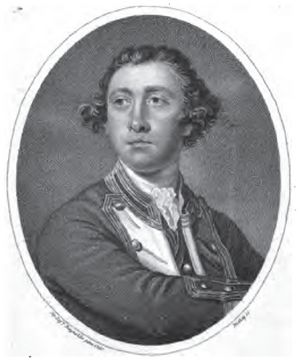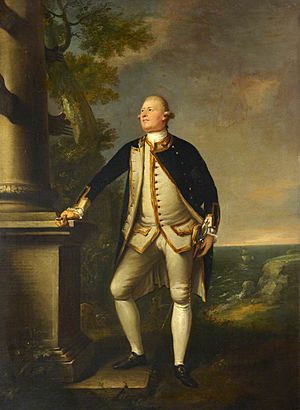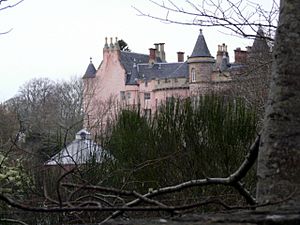John Lockhart-Ross facts for kids
Quick facts for kids
Sir John Lockhart-Ross, 6th Baronet
|
|
|---|---|

Lockhart-Ross c. 1760
|
|
| Born | 11 November 1721 Lockhart Hall, Lanarkshire |
| Died | 9 June 1790 (aged 68) Balnagown Castle, Ross-shire |
| Allegiance | Great Britain |
| Service/ |
Royal Navy |
| Years of service | 1735–1790 |
| Rank | Vice-Admiral |
| Commands held | HMS Vulcan HMS Kent HMS Savage HMS Tartar HMS Chatham HMS Royal George HMS Bedford HMS Shrewsbury |
| Battles/wars | |
| Relations | William Ross, 12th Lord Ross (grandfather) |
Sir John Lockhart-Ross was a brave officer in the British Royal Navy. He was born on November 11, 1721, and passed away on June 9, 1790. He fought in three major wars: the War of the Austrian Succession, the Seven Years' War, and the American War of Independence. He also spent some time as a Member of Parliament, helping to make laws for the country.
John Lockhart, as he was known before 1760, started his naval career as a young man. He quickly became known for his skill, especially when commanding smaller ships called frigates. He successfully hunted down privateers, which were like legal pirates. Later, he took on the name Ross after inheriting land. He then worked to improve his estates and help the people living there.
When another war began, Lockhart-Ross returned to the sea. He commanded ships in important battles and was promoted to a high rank, Vice-Admiral. He helped lead fleets in major victories, like the Battle of Cape St. Vincent. After his naval career, he focused on his land until he died in 1790.
Contents
John Lockhart was born on November 11, 1721, at Lockhart Hall in Lanarkshire, Scotland. He was the fifth son in his family. His mother, Grizel, was the daughter of a nobleman named William Ross.
John joined the navy in September 1735 when he was just 13 years old. His first ship was the 50-gun HMS Portland. He then served on several other ships, sailing to places like the West Indies. He learned a lot about naval life during these years.
Becoming an Officer
On September 28, 1743, John passed his test to become a lieutenant. This meant he could now command parts of a ship. He was assigned to the 44-gun HMS Dover and sailed in the North Sea and off North America. In late 1746, he returned to England.
In April 1747, Lockhart joined the 66-gun HMS Devonshire. This ship was the main ship for Rear-Admiral Peter Warren. Lockhart fought in his first big battle, the First Battle of Cape Finisterre, on May 3, 1747.
First Commands
Soon after, Lockhart got his first chance to command a ship. It was a fireship called HMS Vulcan. He fought in the Second Battle of Cape Finisterre in October 1747. After this battle, he even took temporary command of the 64-gun HMS Kent. For a few years, he was on half pay, which meant he was still in the navy but not actively serving. In 1755, he was promoted to command the 8-gun sloop HMS Savage.
Successful Ship Commands

On March 23, 1756, Lockhart was given command of the 28-gun HMS Tartar. He became famous for hunting down and capturing enemy privateers. These were armed ships owned by private citizens, allowed by their government to attack enemy merchant ships.
Fighting Privateers
Lockhart and the Tartar captured several large privateers. These included the 22-gun Cerf, the 26-gun Grand Gideon, and the 20-gun Mont-Ozier. During the capture of the Mont-Ozier on February 17, 1757, Lockhart was badly hurt. He had to take two months off to recover.
When he returned, he continued his success. On April 15, he captured the 26-gun Duc d'Aiguillon. On November 2, he captured the 36-gun Melampe. This ship was so good that the Royal Navy added it to their own fleet.
Rewards and New Commands
Because of his great success, the British Admiralty offered Lockhart command of a new, larger ship, the 50-gun HMS Chatham. The merchants of London and Bristol also gave him special silver gifts to thank him for protecting their trade. The city of Plymouth gave him the freedom of the borough in a gold box.
Lockhart took command of the Chatham in April 1758. He brought many of his trusted officers and crew from the Tartar with him. He spent the summer cruising in the North Sea, continuing to fight privateers.
Joining the Main Fleet
The Chatham then joined the main British fleet under Sir Edward Hawke. Lockhart also served under Rear-Admiral George Rodney and took part in the Raid on Le Havre. This was an attack on a French port.
Later, his ship was sent to watch the French fleet in Quiberon Bay. When the French fleet sailed out, Lockhart's squadron quickly reported it to Hawke. Hawke then led his fleet to a huge victory at the Battle of Quiberon Bay on November 20, 1759. After this battle, Lockhart was given command of the large 100-gun ship HMS Royal George. In early 1760, he took command of the 64-gun HMS Bedford.
Life on Land and Return to Sea
In September 1760, Lockhart's brother James died. John inherited the large Ross estate of Balnagown. Because of this, he had to add "Ross" to his name, becoming Sir John Lockhart-Ross. He officially changed his name in the spring of 1761.
He took a break from the navy to focus on his new estates. He was elected as a Member of Parliament for Lanark Burghs in June 1761. He didn't spend much time on politics, though. Instead, he worked hard to improve his land and help the local people. He became known as a great farmer and planter, planting millions of pine trees. He was an MP from 1761 to 1768, and then for Lanarkshire from 1768 to 1774.
Back to War
In 1777, war with France seemed likely again. Lockhart-Ross returned to active duty and was given command of the 74-gun HMS Shrewsbury. He joined the fleet under Admiral Augustus Keppel and fought in the Battle of Ushant on July 27, 1778.
On August 13, he became a baronet after his older brothers passed away without sons. This meant he inherited a special title. On March 19, 1779, he was promoted to Rear-Admiral. He served as a senior commander in the Channel Fleet.
Lockhart-Ross continued to serve in major operations. He was with Admiral Rodney during the capture of the Caracas convoy, the Battle of Cape St. Vincent, and the relief of Gibraltar in January 1780. These were important victories that helped Britain.
He also served with George Darby in 1781 and Lord Howe in 1782, helping to relieve Gibraltar again. In August 1782, he retired from active naval service. He was promoted to Vice-Admiral on September 24, 1787.
Sir John Lockhart-Ross died at Balnagown Castle on June 9, 1790. He was married to Elizabeth Dundas and had several children. His eldest son, Charles Lockhart-Ross, inherited his title.


